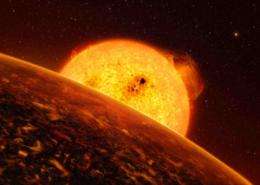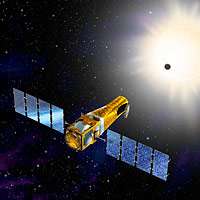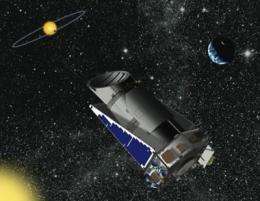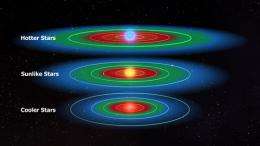Plentiful and Potential Planets

Two planet-hunting telescopes - CoRoT and Kepler - are keeping astronomers hard at work cataloging far-distant planets that orbit other stars in our galaxy. The search for distant planets is essential for astrobiologists who are hunting for habitable, Earth-like worlds beyond our solar system.
Two planet-hunting telescopes -- CoRoT and Kepler -- are keeping astronomers hard at work cataloging far-distant planets that orbit other stars in our galaxy. CoRoT recently reported the discovery of six gas giant planets similar to Jupiter. Kepler, meanwhile, is not confirming the discovery of any planets, but has announced hundreds of planet candidates after only 43 days of scanning the stars.
COROT Catches a Unicorn
The CoRoT space telescope has made seven new discoveries during its observations from Earth orbit - six extrasolar planets and a brown dwarf.
One of the new discoveries is the exoplanet CoRoT-13b. Dr Juan Cabrera, from the German Aerospace Center (DLR) Institute of Planetary Research in Berlin, led a team that authored the publication announcing its discovery. The radius of CoRoT-13b is 90 percent that of Jupiter, making it nearly as big as the largest planet in the solar system. It is very dense, indicating that it has a solid core. The planet orbits a Sun-like star in the constellation of the Unicorn, roughly 4,300 light years distant from us. The rocky exoplanet CoRoT-7b was found in the same region in 2008, causing a stir, as it is very similar to Earth in diameter and mass.

The newly-discovered planets also have distinctive characteristics. CoRoT-10b is a gas planet on an extremely eccentric orbit, so that as it orbits its parent star, it comes very close to the star and also moves very far away. Consequently, during a 13-day orbit, its temperature fluctuates between about 250 degrees and 600 degrees Celsius.
"The density of CoRoT-13b is very high for its mass -2.37 grams per cubic centimetre - nearly double that of Jupiter," says Dr Cabrera. "This suggests that CoRoT-13b has a solid core."
CoRoT-15b, on the other hand, is not a planet but a brown dwarf - the second to have been discovered by CoRoT. Brown dwarfs fill the gap between planets and stars. Because they are much more rare than planets, this finding represents something of a sensation.
Whenever the orbital path of a planet causes it to traverse the line of sight between the CoRoT telescope and its star, it darkens the image of that star slightly for several hours. CoRoT measures this reduction in brightness. This technique, known as the planetary transit method, allows astronomers to determine the orbital period of the planet, its distance from the star and its radius. The planet's mass can then be determined in combination with subsequent measurements taken by ground-based telescopes. Transiting exoplanets being tracked by CoRoT are of great interest, since this is the only way of determining the planet's density. From these measurements, it can be inferred whether the planets are rocky exoplanets such as Venus, Earth and Mars, or gaseous planets like Jupiter and Saturn.
Transiting exoplanets are the extrasolar planets about which the most accurate data has been obtained. Of the roughly 450 extrasolar planets that have been discovered in the last 15 years, 82 have been observed as transiting exoplanets. Of these 82, CoRoT has detected fifteen.
"We look forward to every new member of the CoRoT family. This shows how successful the mission is," said Prof. Heike Rauer of the DLR Institute of Planetary Research, who directs the German contribution to the CoRoT mission and whose department is involved in scientific analysis. "Every new discovery contributes to a deeper understanding of the formation and evolution of planetary systems. In this way, we can answer the question whether our solar system is an exceptional case, or whether other, similar planetary systems exist."
CoRoT was launched at the end of 2006, and now orbits Earth every two hours in a polar orbit at an altitude of 900 kilometres. The mission is led by the French space agency CNES. DLR has also made substantial contributions to the mission from the outset. The CoRoT mission has now been extended until March 2013.
Kepler's Copious Count
NASA's Kepler Mission has released 43 days of science data on more than 156,000 stars. These stars are being monitored for subtle brightness changes as part of an ongoing search for Earth-like planets outside of our solar system.

Astronomers will use the new data to determine if orbiting planets are responsible for brightness variations in several hundred stars. These stars represent a full range of temperatures, sizes and ages. Many of them are stable, while others pulsate. Some show starspots, which are similar to sunspots, and a few produce flares that would sterilize their nearest planets.
Kepler, a space observatory, looks for the data signatures of planets by measuring tiny decreases in the brightness of stars when planets cross in front of, or transit, them. The size of the planet can be derived from the change in the star's brightness.
The 28-member Kepler science team also is using ground-based telescopes and NASA's Hubble Space Telescope and Spitzer Space Telescope to perform follow-up observations on a specific set of 400 objects of interest. The star field that Kepler observes in the constellations Cygnus and Lyra can only be seen from ground-based observatories in spring through early fall. The data from these other observations will determine which of the candidates can be identified as planets. That data will be released to the scientific community in February 2011.

Without the additional information, candidates that are actual planets cannot be distinguished from false alarms, such as binary stars -- two stars that orbit each other. The size of the planetary candidates also can be only approximated until the size of the stars they orbit is determined from additional spectroscopic observations made by ground-based telescopes.
"I look forward to the scientific community analyzing the data and announcing new exoplanet results in the coming months," said Lia LaPiana, Kepler's program executive at NASA Headquarters in Washington.
"This is the most precise, nearly continuous, longest and largest data set of stellar photometry ever," said Kepler Deputy Principal Investigator David Koch of NASA's Ames Research Center in Moffett Field, Calif. "The results will only get better as the duration of the data set grows with time."
Kepler will continue conducting science operations until at least November 2012, searching for planets as small as Earth, including those that orbit stars in a warm, habitable zone where liquid water could exist on the surface of the planet. Since transits of planets in the habitable zone of solar-like stars occur about once a year and require three transits for verification, it is expected to take at least three years to locate and verify an Earth-size planet.
"The Kepler observations will tell us whether there are many stars with planets that could harbor life, or whether we might be alone in our galaxy," said the mission's science principal investigator, William Borucki of Ames.
To see the science data, visit: archive.stsci.edu/kepler .
Source: Astrobio.net




















